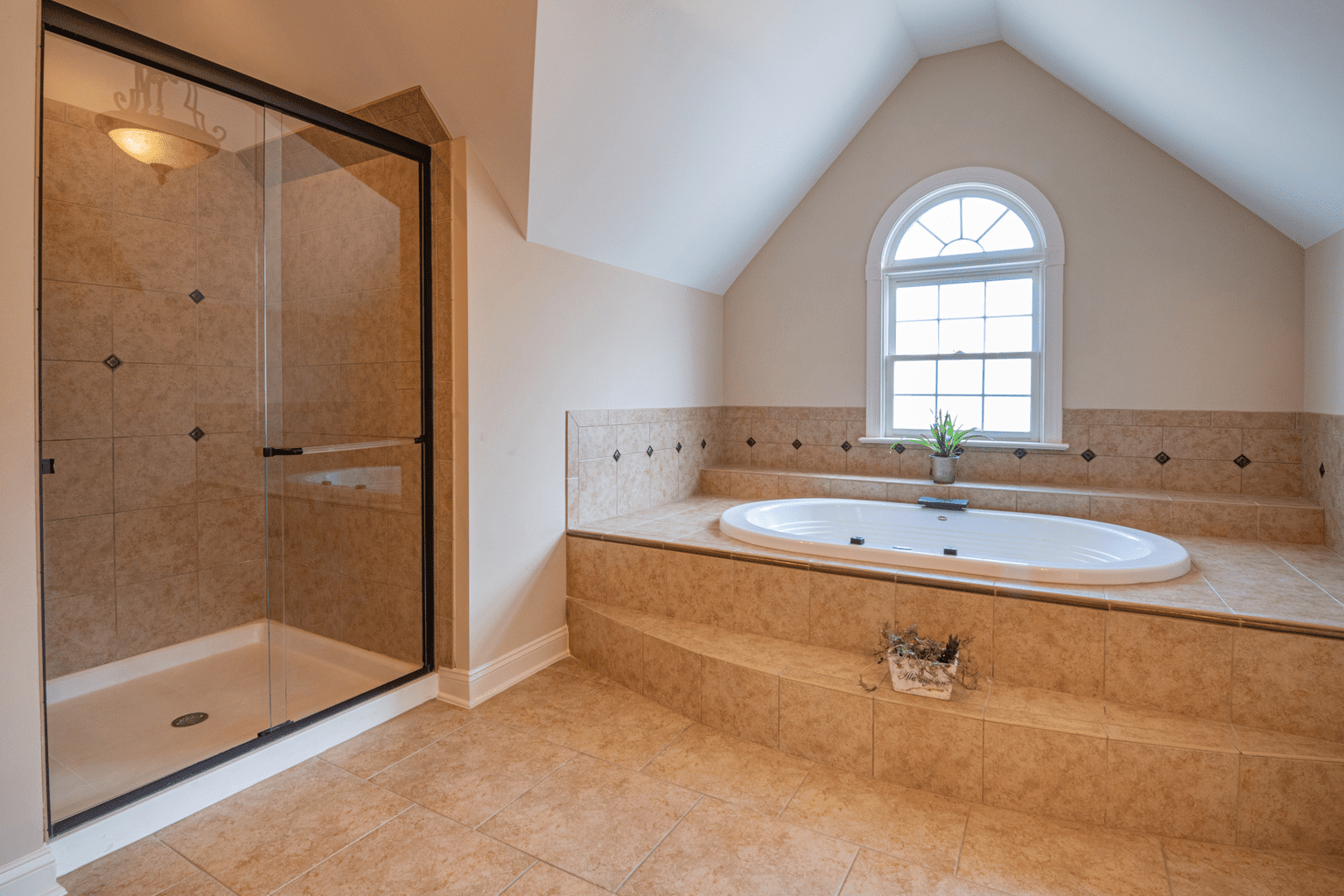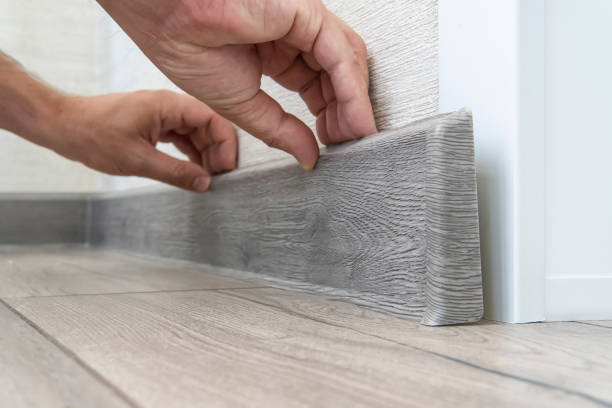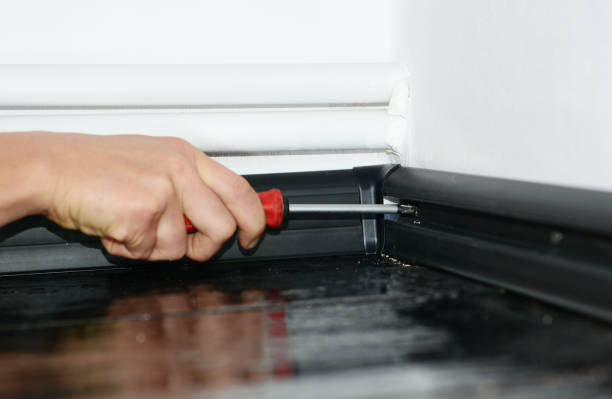Bathroom baseboards are one of the essential parts of every bathroom.

Not only are they one of the most important contributors to the bathroom’s visual design, but they also play several critical roles in the overall functionality of your bathroom.
Today, we’ll provide you with more details about bathroom baseboards and their functions.
What are Bathroom Baseboards Supposed To Do?
While having a baseboard in your bathroom isn’t necessary, installing one is still a good idea, as it will significantly reduce the maintenance your bathroom will need and reduce the likelihood of encountering specific issues.
Here are some main reasons to put a baseboard into your bathroom.
Preventing Moisture Seepage
Firstly, a baseboard protects your walls from moisture damage. A bathroom floor is usually wet, so making a baseboard of a water-resistant material is essential.
The moisture content will thus be unable to enter the walls at the ground level, allowing it to evaporate and thus keeping your bathroom walls moisture and mold-free.
Protecting the Floor Level of the Wall From Stains
It is not just the moisture that can damage your bathroom floors and walls. In case of a flood or any kind of filth spilling onto the floors, the surrounding walls are likely to get stained. A bathroom baseboard can prevent these stains from appearing, protecting your bathroom wall from getting damaged.
Improving the Bathroom’s Aesthetic
A high-quality baseboard can also make your bathroom wall more visually appealing. It contrasts the floor tiles and the single-colored drywall above it, breaking the monotony of your bathroom.
What are the Most Popular Baseboard Materials?
Depending on the goal you want to accomplish by adding a baseboard to your bathroom wall and the room’s construction, you will be able to choose from various materials.
Here is a list of all the materials commonly available in home improvement stores that can be used to make a bathroom baseboard.
Wood Baseboards
Wood baseboards are usually considered to be a very aesthetically pleasing option, but they aren’t exactly cheap. Furthermore, a wood baseboard needs to be stained before construction and sealed when installing it in your bathroom.
There are two main types of wood baseboards: pinewood and oakwood. The former is cheaper than the latter, but both suffer from the same issue: vulnerability to water damage.
Furthermore, people often combine these baseboards with hardwood floors in their bathrooms, making flooding a devastating problem as the excess moisture causes the wooden baseboards to crack.
PVC Baseboards
In stark contrast to wood baseboards, PVC baseboards are almost entirely resistant to any sort of water damage and are even used to protect uneven walls from getting damaged further.
Unfortunately, it is quite an expensive option and doesn’t look as elegant as a traditional baseboard made of wood.
Still, as you won’t have the additional expense of caulking the edges of your baseboard with a sealant every so often, PVC is still a relatively good choice if you don’t mind frontloading your costs.
Vinyl Baseboards
A variant of the ordinary PVC baseboards, vinyl is a little less water resistant and doesn’t look as good as it is harder to color.
Still, it also drastically reduces the price, making it a decent budget option for protecting the wet area of your bathroom.
Tile Baseboards
A timeless classic, tile baseboards were once reserved for luxurious bathrooms in homes of the wealthy. They are still popular, as they protect your walls from dirt and debris while seamlessly fitting into most bathrooms.
However, while tile baseboards improve the structural integrity of your floors as they are highly water resistant, they also need a lot of cleaning from dust and debris that sticks to them.
Rubber Baseboards
A reasonably unusual choice, a rubber baseboard is still a great way to protect your house from moisture, as it provides the walls with high water resistance.
Rubber is also relatively cheap, being a middle-of-the-road option regarding the size of your initial investment.
Unfortunately, it also looks quite awkward, making it an unpopular choice among homeowners even if it does eliminate any water damage.
MDF Baseboards
MDF is the cheapest baseboard material out there, making it an excellent choice for those operating on a tight budget.
Unfortunately, it isn’t waterproof, requiring additional investment to cover it with sealant before it can be used in the bathroom.
MDF is a typical budget choice, offering a simple solution to deter dust and dirt from reaching your wall while being far from the best baseboard material out there.
Stone Baseboard
Much like a rubber one, a stone baseboard is quite an uncommon sight to see in modern houses. It is, however, quite viable and looks great if combined with stone flooring or walls.
There are both upsides and downsides to this choice.
However, the material is highly durable and water resistant, protecting your flooring and walls from moisture, but it is extremely expensive to install and requires a lot of cleaning and maintenance.
Things To Consider When You Install Baseboards In the Bathroom
Before you start installing the baseboard, you will have to gather some information about the layout of your bathroom.
This information is essential to the installation process, as it ensures that you have the exact materials you need while also helping you project the costs.
The Size and Height of Your Baseboard
Before you move on to the following steps, you will need to decide whether you want to waterproof the entire bathroom wall or just the wet area.
Once you have done this, you will also have to choose the baseboard height.
The height of your baseboard will depend on the moisture level in the bathroom, with higher baseboards being better than shorter ones. Usually, a baseboard will be between 4 and 8 inches tall, protecting the walls from flooding.
How are You Going To Handle Edges and Angles?
Bathrooms usually have a rectangular shape, and each corner, whether at an obtuse or acute angle, will present a problem when installing your baseboard.
Installing one in your bathroom is an exact process, so you should always hire a professional with all the necessary tools and experience to use them correctly.
This remains true regardless of the baseboard material you choose.
Determine the Level of Your Bathroom Floor
A level floor can make installing a baseboard much easier as it saves time you would otherwise spend on making adjustments.
Luckily, tile floors that are the most common in modern bathrooms are usually perfectly level. Still, using a level before starting work is a great choice.
Find Skilled Professionals To Install the Baseboard for You
While it is possible to install a baseboard on your own, it is a much better idea to hire a skilled handyperson, as he will have all the tools necessary to perform the job.
While this will lead to a steep increase in the overall cost, it will also raise the quality of the work, increasing its durability and longevity.
3 Tips on Installing a Bathroom Baseboard
Here are some quick tips that you should follow to make your baseboard installment smoother.
Measure Everything at Least a Few Times
Having correct and accurate measurements of each surface in your bathroom will let you know exactly how much material you need, as well as help with cutting that material afterward.
Clean the Walls Before Any Installations
You can use a knife to clean off any scrapes from the wall, removing imperfections and thus making it easier to connect the baseboards.
You can also use sandpaper to make the wall even smoother.
Do everything you can to make the angles as straight as possible
The closer to a 90-degree angle you can get, the easier it will be to fit the cut pieces of baseboard into the corners. Because of this, caulking the corners of each wall is a good idea if they are not entirely straight already.
Frequently Asked Questions
What Kind of Baseboard Do You Use In a Bathroom?
The most important feature of bathroom baseboards is their water resistance. Thus, materials such as tile, PVC, and rubber perform well, more so than ones such as wood or MDF.
Do You Put Baseboards in Bathrooms?
Yes, putting a baseboard in your bathroom can be excellent to protect its walls from being damaged by the ever-present moisture.
How Do You Waterproof Bathroom Baseboards?
Some materials, such as PVC, rubber, or stone, are waterproof by default. Others, like wood or MDF, must undergo caulking and be sealed with water rewater-resistant before they become helpful for a bathroom baseboard.
Are there water-resistant baseboards?
Indeed, materials such as tile, stone, and PVC have naturally high water resistance, making them an excellent choice for your bathroom baseboard.
Conclusion
Installing a baseboard to your bathroom wall is an excellent way to protect it from the damaging effects of moisture and stains left by dirt and debris that every bathroom gets filled with.
That being said, there are many different materials you can use to make such a baseboard, each with its own advantages and disadvantages, making it essential to research before you begin the installation process.


